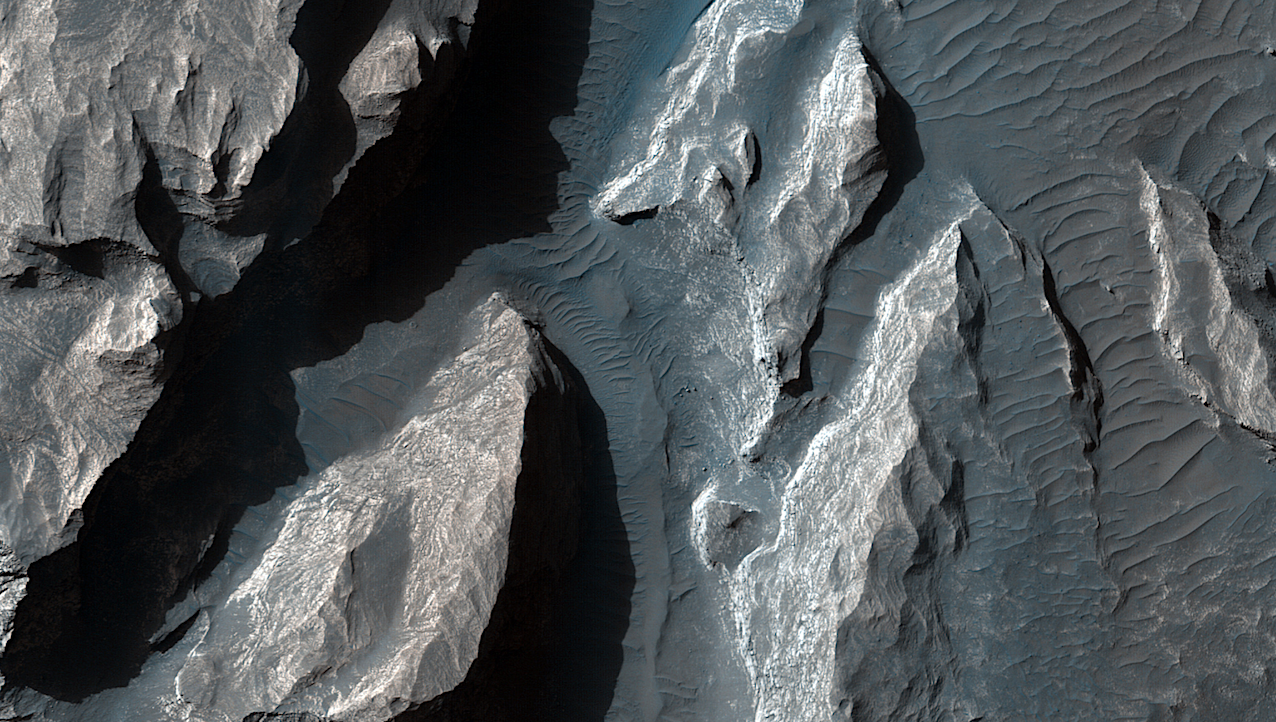Science
Scientists Discover Ancient Lake Evidence in Arsinoes Chaos on Mars

Recent observations have revealed intriguing evidence of a possible ancient lake on Mars, specifically within the region known as Arsinoes Chaos. Researchers have identified a unique light-toned deposit that contrasts sharply with its surrounding chaotic terrain. This discovery could provide critical insights into the planet’s geological history and its capacity to support life.
The focus of this investigation is a rough-surfaced deposit that exhibits signs of erosion, suggesting it was shaped by fluid movements. The surface features indicate that the fluid may have flowed both north and south, lending credence to the theory that this deposit formed in a long-gone lake. Such findings are significant in the fields of astrobiology and astrogeology, as they may indicate past environments that could have been conducive to life.
Understanding the Geological Context
The Arsinoes Chaos region is characterized by its complex geological formations, which include large depressions and chaotic terrain that suggest significant past geological activity. This area is thought to have been influenced by various processes, including water erosion, which has sculpted the landscape over millions of years.
The light-toned deposit being studied is particularly noteworthy due to its rough texture. In contrast, the surrounding areas display a smoother appearance, highlighting the potential impact of historical water flow. The characteristics of this deposit suggest that it could be a remnant of an ancient lakebed, possibly providing a habitat for microbial life in Mars’ distant past.
This research aligns with ongoing efforts by organizations such as NASA to explore the history of water on Mars. Understanding the presence and movement of water is crucial for assessing the planet’s habitability. The findings from Arsinoes Chaos may help scientists piece together the planet’s climatic history and its transition from a potentially habitable environment to the arid landscape observed today.
Implications for Future Research
The implications of this discovery extend beyond mere geological interest. If confirmed as remnants of an ancient lake, the deposit could inform future missions aimed at searching for signs of past life on Mars. As technology advances, researchers are increasingly able to analyze Martian features from orbit, providing a broader understanding of the planet’s surface composition and history.
In conclusion, the light-toned deposit in Arsinoes Chaos represents a significant find in Martian research. As scientists continue to study this area, the potential for uncovering more evidence of water and past life on Mars remains a compelling aspect of planetary exploration. Understanding Mars’ past could ultimately shape humanity’s future endeavors to explore and possibly inhabit other worlds.
-

 Health4 days ago
Health4 days agoRare Brain Condition Discovered More Common in New Mexico
-

 Politics5 days ago
Politics5 days agoPrince Andrew Steps Back from Royal Duties Following Epstein Memoir
-

 Sports5 days ago
Sports5 days agoMLS Decision Day 2025: Playoff Spots on the Line as Teams Clash
-

 Science5 days ago
Science5 days agoIdaho State University Launches Haunted Science Laboratory on Oct. 25
-

 World5 days ago
World5 days agoYoung Driver Dies in Collision with Box Truck in El Cajon
-

 Lifestyle5 days ago
Lifestyle5 days agoKent Hamilton Named Southeastern Farmer of the Year at Expo
-

 Health5 days ago
Health5 days agoRemembering Mary Ingleby: A Life of Love, Teaching, and Music
-

 Business5 days ago
Business5 days agoFirst National Bank of Groton’s Quiet Period Ends October 21
-

 Entertainment5 days ago
Entertainment5 days agoTrump Commutes George Santos’ Sentence, Sparks Controversy
-

 Politics5 days ago
Politics5 days agoNavy Veteran Max Quattromani Launches Campaign for Assessor Seat
-

 Sports5 days ago
Sports5 days agoSaquon Barkley Reacts to James Franklin’s Dismissal from Penn State
-

 Top Stories6 days ago
Top Stories6 days agoCommunity Gathers for Thrilling 25th Annual Chili Fest Today









